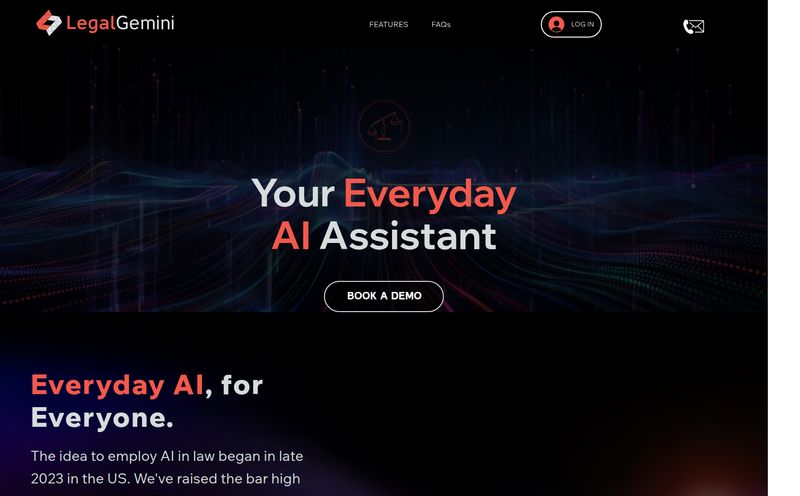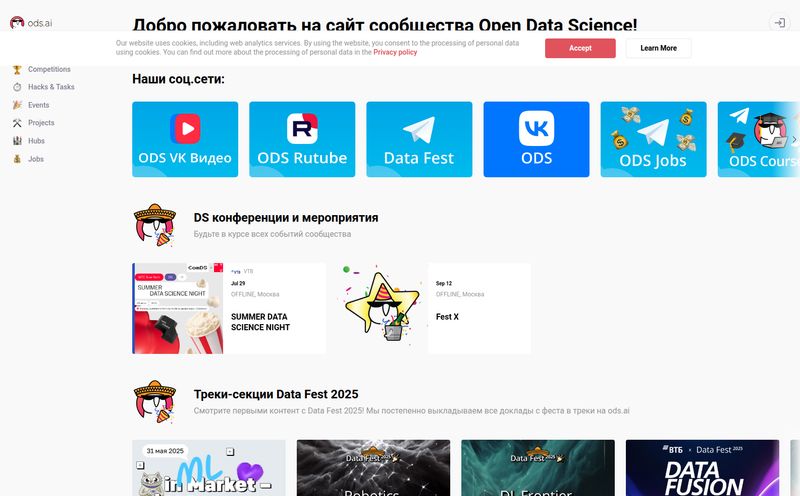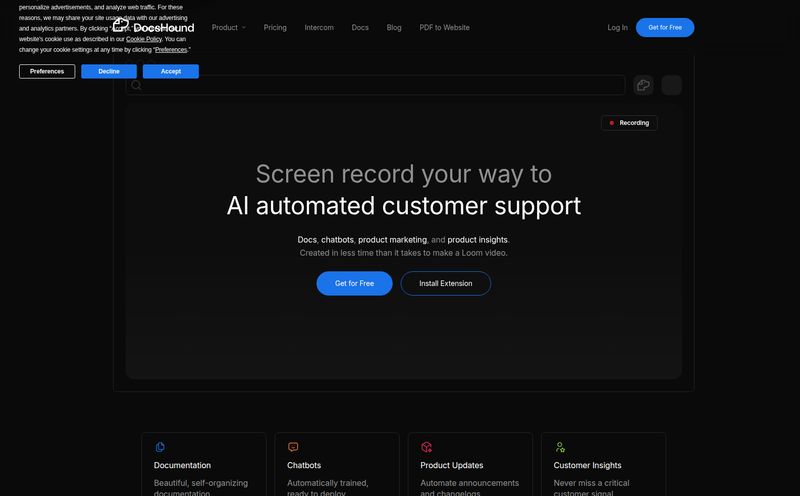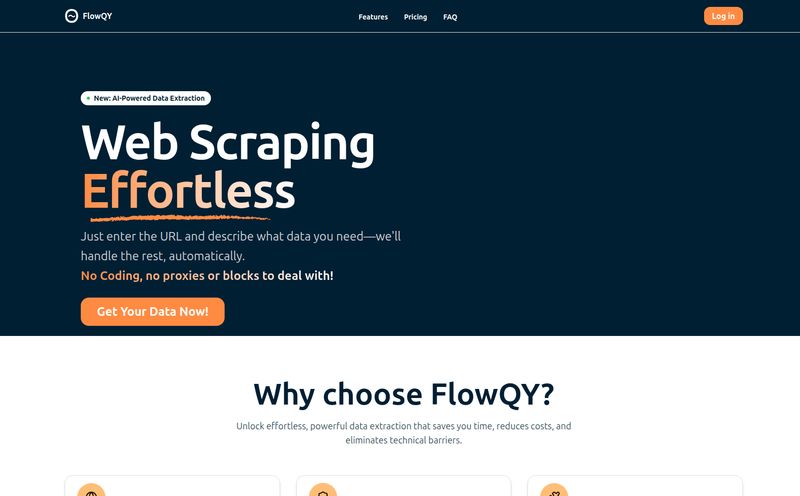We're all caught in this whirlwind romance with AI. It's exciting, it's powerful, and it promises to change... well, everything. But there’s this nagging feeling in the back of our minds, right? This quiet little voice that whispers, "Where is all my data going?" Every time we feed a prompt into a public model, we're essentially tossing our company secrets over a digital fence and hoping for the best.
For years, the choice has felt binary: innovate with AI and risk your data, or lock everything down and get left behind. It’s a terrible choice to have to make. I've been in the traffic and SEO game long enough to see trends come and go, but this tension between innovation and security is a permanent fixture. So when a platform comes along with a tagline like "Your Data Stays Yours. Always," you can bet it gets my attention.
That platform is TRMX, and its promise is to let you build powerful, enterprise-grade AI agents without your data ever leaving your control. Sounds too good to be true? Maybe. Let's dig in.
What on Earth Are TRMX and this MCP Playground?
Okay, so let's break it down. TRMX is the main stage—it's the Serverless MCP Platform. The 'MCP Playground' is its trusty sidekick, an open-source tool for testing and debugging what you build. Think of TRMX as the kitchen where you cook up your AI solutions, and the Playground is where you taste-test everything before serving it.
The big hook here is that it's designed to be a no-code platform. The idea is to empower teams to create their own AI agents and solutions without needing a battalion of developers. You're connecting building blocks, not writing endless lines of Python. This lowers the barrier to entry, which is always a good thing in my book. It democratizes the tech, taking it out of the exclusive hands of a few code-wielding wizards.
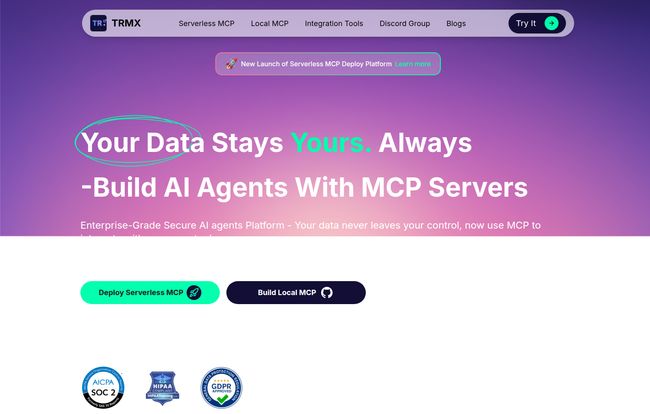
Visit MCP Playground
The Deployment Trinity: Your Data, Your Rules
This is where TRMX really starts to shine for me. It’s not a one-size-fits-all solution. Instead, it gives you three distinct ways to deploy your AI agents, depending on your paranoia level—I mean, your security requirements.
Keeping it Close with On-Computer Deployment
This is the Fort Knox option. Your data and the AI agent live entirely on your local machine or on-premise server. Nothing goes to the cloud. Ever. For industries like healthcare, finance, or legal, this isn't just a feature; it's a necessity. It’s how a company like Doctorhub, who they feature in a testimonial, can use AI for patient data while maintaining strict HIPAA compliance. The data simply never leaves the building.
The Private Cloud Advantage
Sometimes your team is spread out, and you need that collaborative magic that the cloud provides. The 'Cloud' option here isn't just tossing your data onto some random public server. It’s about deploying into your own private cloud. You get the accessibility and scalability of a cloud environment but within a secure, contained space that you control. This is perfect for retail or travel companies who need team-wide access without compromising security protocols.
The Best of Both Worlds with Hybrid
This one is clever. The Hybrid model keeps your sensitive data stored locally, on-computer, but allows the AI agent itself to live in the cloud. Why? So it can securely connect with all your favorite SaaS tools. Your sales team's agent can talk to Salesforce and your marketing team's agent can interface with your reporting tools, all without your core customer data ever being uploaded. Its a pretty elegant solution to a very common problem.
Connecting the Dots with SaaS Integrations
An AI tool that doesn't play well with others is pretty useless. It just becomes another silo. TRMX seems to get this. Their whole diagram is a spiderweb of connections. We're talking about direct integrations with the tools your business likely already runs on:
- Collaboration: Notion, Slack, Google Cloud
- CRM & Sales: Salesforce, Zendesk, Freshdesk
- AI Models: Groq, Mistral, Anyscale
This is huge. It means you're not replacing your workflow; you're augmenting it. You're building an AI layer on top of what you already do, making your existing tools smarter and more efficient. That's a much easier sell to the C-suite than a full-scale digital transplant.
Security Is Not an Afterthought Here
I see so many startups slap a "secure" sticker on their website and call it a day. TRMX, on the other hand, puts its compliance credentials front and center. SOC 2, HIPAA, GDPR. These aren't just buzzwords; they're grueling, expensive, and difficult standards to meet.
"Achieving SOC 2 or HIPAA compliance is a massive undertaking. It tells you that the company has built its entire infrastructure around verifiable security processes, not just good intentions."
Seeing these logos tells me that data security isn't a marketing point; it's part of their core DNA. It’s the foundational promise that holds the entire platform up. If you're a CTO or a compliance officer, this is the part where you can start to relax a little.
The 'No-Code' Promise: How Real Is It?
Alright, let's talk about the elephant in the room. "No-code." I've seen it a thousand times, and it often means "less code" or "no code until you want to do something complicated." Based on their own provided info, TRMX isn't entirely immune to this. They admit that some technical knowledge might be required to get things set up and configured. I appreciate the honesty.
So, can your marketing manager build a complex, multi-step AI agent on day one? Probably not. But can your slightly-more-technical team lead get a secure, internal Q&A bot running on your company documents in an afternoon? It certainly seems so. Think of it less as a magic wand and more as a very powerful and user-friendly toolkit. You still need to know how to hold the tools, but you don't need to forge them yourself.
So, What's the Catch?
No tool is perfect, right? Besides the potential learning curve, the other big question mark is the price. And here's where my journalistic adventure hit a small snag. I went looking for the pricing page, clicked the link... and was greeted by a beautiful, crisp 404 Page Not Found. You gotta love the authenticity of the web sometimes.
This, combined with the lack of public pricing info, tells me one thing: TRMX is likely targeting enterprise clients with custom packages. This isn't a $20/month SaaS tool you can just swipe a credit card for. You're going to have to talk to a sales rep, discuss your needs, and get a custom quote. For a platform this focused on security and custom deployment, that makes perfect sense, but it's something to be aware of if you're a small startup looking for a quick fix.
Conclusion: Is TRMX the Secure AI Bridge We Need?
After looking it all over, I’m genuinely intrigued. TRMX isn't trying to be another generic AI chatbot. It’s tackling a very specific, and very important, problem: how to leverage the power of AI without compromising on data security. The flexible deployment options are the star of the show, giving businesses the power to choose exactly where their data lives.
Is it for everyone? No. If you're a solo blogger who just wants to generate some social media posts, this is probably overkill. But if you're a business, especially in a regulated industry, and you've been sitting on the AI sidelines out of security concerns, TRMX might just be the platform that gets you in the game. It’s a serious tool for serious businesses who take their data seriously. And in today's world, that’s a very valuable thing indeed.
Frequently Asked Questions
- 1. What is TRMX in simple terms?
- TRMX is a platform that lets you build your own AI agents and solutions without needing to code. Its main focus is on data security, ensuring your company's information stays under your control.
- 2. Do I need to be a programmer to use TRMX?
- For the most part, no. It's designed as a no-code platform. However, for more complex setups and initial configuration, some technical familiarity will definitely be helpful.
- 3. Is TRMX secure for handling sensitive data like medical records?
- Yes, it's built for it. With options for on-premise deployment and compliance with standards like HIPAA, SOC 2, and GDPR, it's designed specifically for securing sensitive data.
- 4. What kind of tools can I integrate with TRMX?
- You can connect it to a wide range of popular SaaS tools, including Salesforce, Zendesk, Slack, Notion, and various AI model providers like Groq and Mistral.
- 5. How much does TRMX cost?
- Pricing is not publicly listed on their website. This typically means they offer custom, enterprise-level packages, and you'll need to contact their sales team for a quote based on your specific needs.
- 6. What's the difference between on-computer, cloud, and hybrid deployment?
- On-computer keeps all data and the AI agent on your local servers. Cloud deploys to your private cloud for team access. Hybrid keeps data local but lets the AI agent run in the cloud to connect with other online tools securely.
Reference and Sources
- The official TRMX Platform Website: https://www.trmx.ai/
- An overview of SOC 2 Compliance from the AICPA: AICPA SOC 2 Information
- U.S. Department of Health & Human Services on HIPAA: HHS.gov - Health Information Privacy
